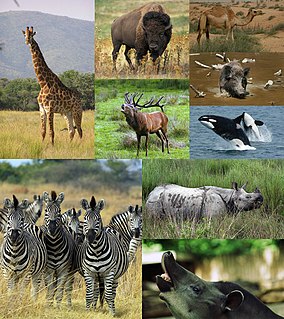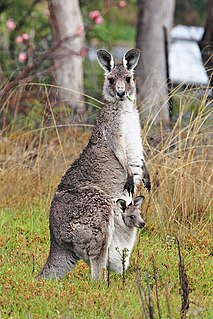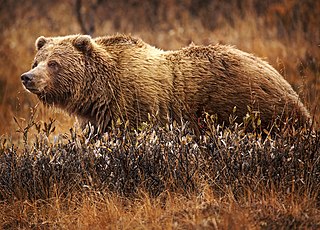
The Cenozoic is Earth's current geological era, representing the last 66 million years of Earth's history. It is characterized by the dominance of mammals, birds and flowering plants, a cooling and drying climate, and the current configuration of continents. It is the latest of three geological eras since complex life evolved, preceded by the Mesozoic and Paleozoic. It started with the Cretaceous–Paleogene extinction event, when many species, including the non-avian dinosaurs, became extinct in an event attributed by most experts to the impact of a large asteroid or other celestial body, the Chicxulub impactor.

A carnivore, meaning "meat eater", is an animal whose food and energy requirements derive solely from animal products whether through hunting or scavenging. Animals that depend solely on animal flesh for their nutrient requirements are called hypercarnivores or obligate carnivores, while those that also consume non-animal food are called mesocarnivores or facultative carnivores. Omnivores also consume both animal and non-animal food, and apart from the more general definition, there is no clearly defined ratio of plant vs. animal material that would distinguish a facultative carnivore from an omnivore. A carnivore at the top of the food chain, not preyed upon by other animals, is termed an apex predator.

Mammals are a group of vertebrate animals constituting the class Mammalia, and characterized by the presence of mammary glands which in females produce milk for feeding (nursing) their young, a neocortex, fur or hair, and three middle ear bones. These characteristics distinguish them from reptiles and birds, from which they diverged in the Carboniferous, over 300 million years ago. Around 6,400 extant species of mammals have been described. The largest orders are the rodents, bats and Eulipotyphla. The next three are the Primates, the Artiodactyla, and the Carnivora.

Marsupials are any members of the mammalian infraclass Marsupialia. All extant marsupials are endemic to Australasia and the Americas. A distinctive characteristic common to most of these species is that the young are carried in a pouch. Well-known marsupials include opossums, Tasmanian devils, kangaroos, koalas, wombats, wallabies, bandicoots, and the extinct thylacine.

Ungulates are members of the diverse clade Ungulata which primarily consists of large mammals with hooves. These include odd-toed ungulates such as horses, rhinoceroses, and tapirs; and even-toed ungulates such as cattle, pigs, giraffes, camels, sheep, deer, and hippopotamuses. Cetaceans such as whales, dolphins, and porpoises are also classified as even-toed ungulates, although they do not have hooves. Most terrestrial ungulates use the hoofed tips of their toes to support their body weight while standing or moving.

Placentalia is one of the three extant subdivisions of the class of animals Mammalia; the other two are Monotremata and Marsupialia. The placentals are partly distinguished from other mammals in that the fetus is carried in the uterus of its mother to a relatively late stage of development. The name is something of a misnomer considering that marsupials also nourish their fetuses via a placenta, though for a relatively briefer period, giving birth to less developed young who are then kept for a period in the mother's pouch.

Shrews are small mole-like mammals classified in the order Eulipotyphla. True shrews are not to be confused with treeshrews, otter shrews, elephant shrews, West Indies shrews, or marsupial shrews, which belong to different families or orders.

Synapsids are a group of animals that includes mammals and every animal more closely related to mammals than to the other members of the amniote clade, such as reptiles and birds. Unlike other amniotes, they have a temporal fenestra, an opening low in the skull roof behind each eye, leaving a bony arch beneath each; this accounts for their name. Primitive synapsids are usually called pelycosaurs or pelycosaur-grade synapsids. This informal term consists of all synapsids that are not therapsids, a monophyletic, more advanced, mammal-like group. The non-mammalian synapsids were described as mammal-like reptiles in classical systematics, but this misleading terminology is no longer in use as synapsids as a whole are no longer considered reptiles. They are now more correctly referred to as stem mammals or proto-mammals.

Eutheria is the clade consisting of all therian mammals that are more closely related to placentals than to marsupials.

Theria is a subclass of mammals amongst the Theriiformes. Theria includes the eutherians and the metatherians.

Euarchontoglires is a clade and a superorder of mammals, the living members of which belong to one of the five following groups: rodents, lagomorphs, treeshrews, colugos and primates.

Didelphodon is a genus of stagodont metatherians from the Late Cretaceous of North America.

Theriiformes is a subclass of mammals. The term was coined in 1997 by McKenna & Bell in their classification of mammals. In the strict sense, it is defined as all mammals more closely related to therians than to monotremes.

Zatheria is a group (sublegion) of mammals that includes the common ancestor of Arguimuridae, Vincelestidae, Peramuridae, and Tribosphenida.

Tribosphenida is a group (infralegion) of mammals that includes the ancestor of Hypomylos, Aegialodontia and Theria. Its current definition is more or less synonymous with Boreosphenida.

Laurasiatheria is a superorder of placental mammals that groups together order Eulipotyphla and clade Scrotifera. It is a sister group to Euarchontoglires with which it forms the magnorder Boreoeutheria. Laurasiatheria was discovered on the basis of the similar gene sequences shared by the mammals belonging to it; no anatomical features have yet been found that unite the group. The Laurasiatheria clade is based on DNA sequence analyses and retrotransposon presence/absence data. The superorder originated on the northern supercontinent of Laurasia, after it split from Gondwana when Pangaea broke up. Its last common ancestor is supposed to have diversified ca. 76 to 90 million years ago.

Mammaliaformes ("mammal-shaped") is a clade that contains the crown group mammals and their closest extinct relatives; the group radiated from earlier probainognathian cynodonts. It is defined as the clade originating from the most recent common ancestor of Morganucodonta and the crown group mammals; the latter is the clade originating with the most recent common ancestor of extant Monotremata, Marsupialia, and Placentalia. Besides Morganucodonta and the crown group mammals, Mammaliaformes includes Docodonta and Hadrocodium as well as the Triassic Tikitherium, the earliest known member of the group.

Fur is a thick growth of hair that covers the skin of many different animals, particularly mammals. It consists of a combination of oily guard hair on top and thick underfur beneath. The guard hair keeps moisture from reaching the skin; the underfur acts as an insulating blanket that keeps the animal warm.

Cladotheria is a group (legion) of mammals that includes the ancestor of Dryolestida, Amphitheriida, Peramuridae and Zatheria.

Monotremes are one of the three main groups of living mammals, along with placentals (Eutheria) and marsupials (Metatheria). The monotremes are typified by structural differences in their brains, jaws, digestive tract, reproductive tract, and other body parts compared to the more common mammalian types. In addition, they lay eggs rather than bearing live young, but, like all mammals, the female monotremes nurse their young with milk.





















